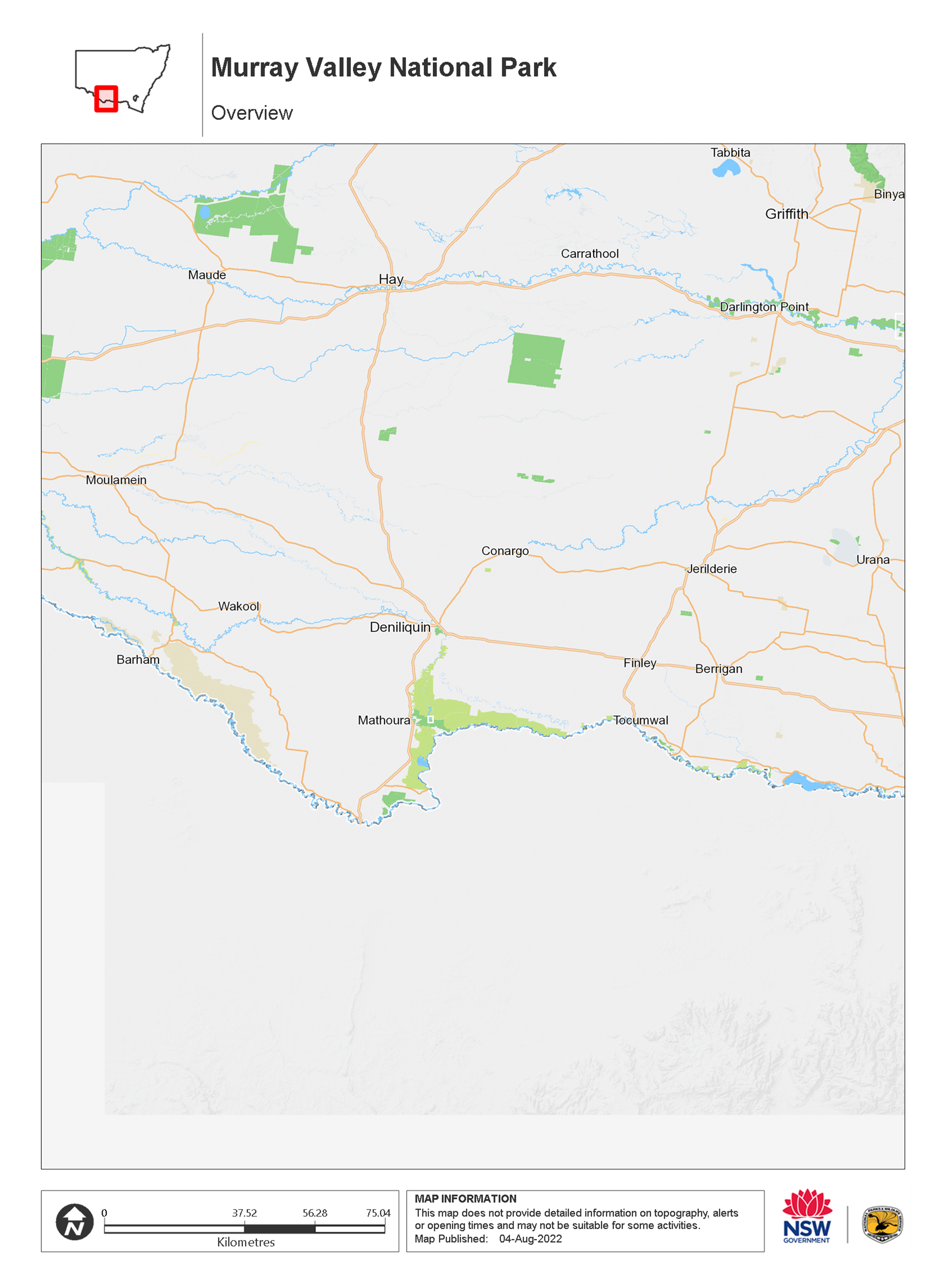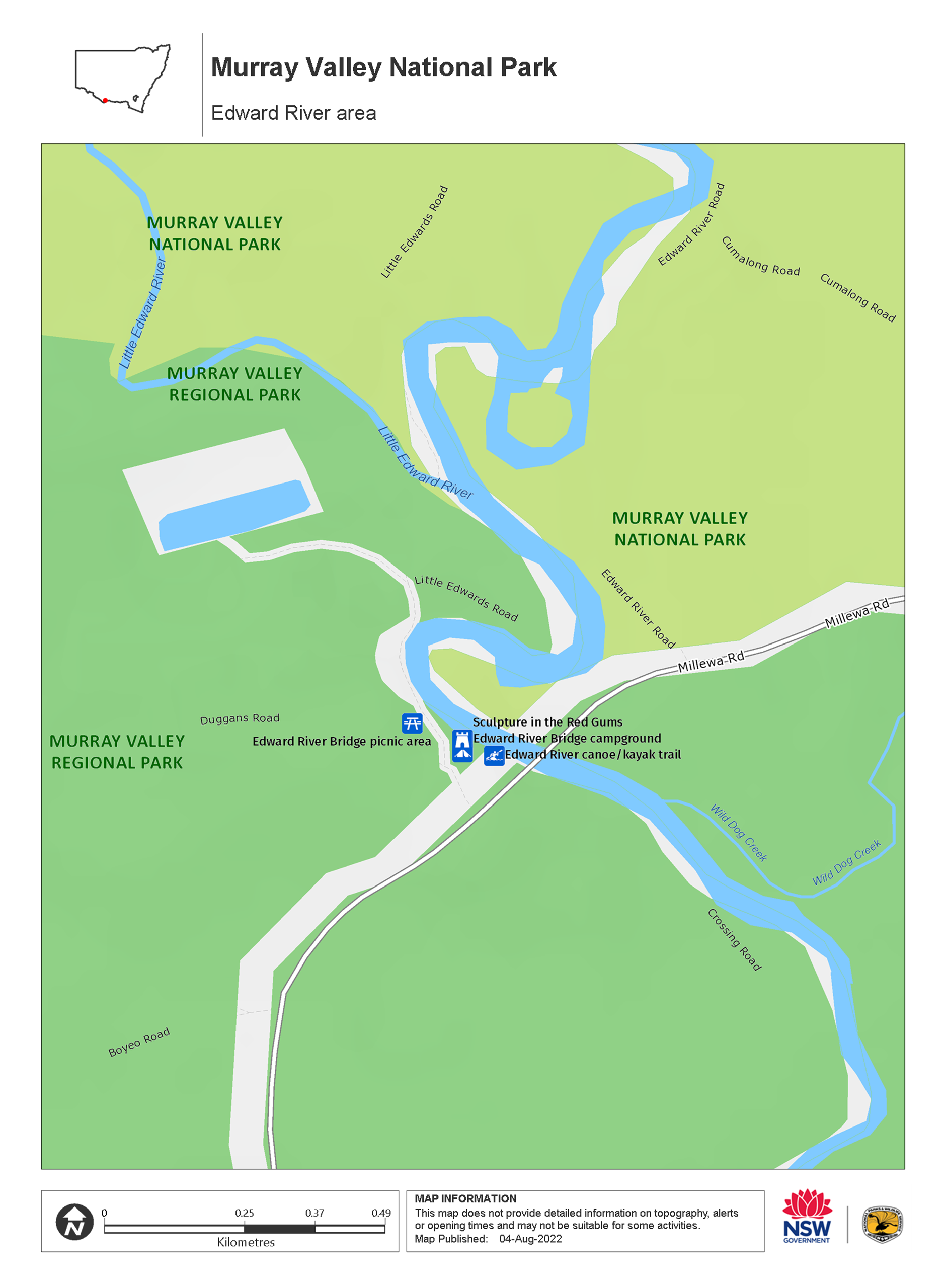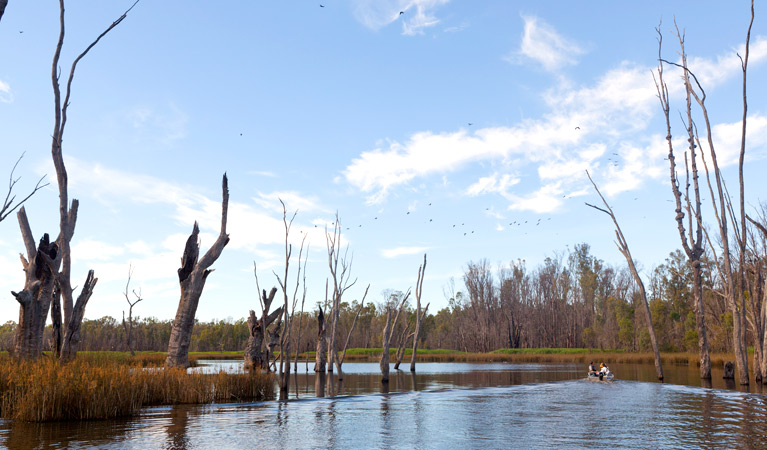Murray Valley National Park
Overview
Explore majestic river red gums or Ramsar-listed wetlands in Murray Valley National Park on a camping trip to the Riverina. Go birdwatching, fishing, bike riding and kayaking.
Read more about Murray Valley National Park
Murray Valley National Park and nearby Murray Valley Regional Park were established to protect the majestic river red gum forests of the Riverina’s Ramsar-listed wetland.
Part of the largest continuous red gum forest in the world, this region hosts a unique ecosystem with over 60 threatened native animal species and 40 threatened plant species. It is also an important place for Aboriginal people.
There are lots of things to do. Fish for your dinner in the mighty Murray and paddle along the river in a canoe or kayak. If you're interested in birds, be sure to check out Reedbeds Bird Hide and look out for the yellow rosella as you ride the park's trails. After a day exploring, camp out overnight by the river at one of the park's many campgrounds.
Local alerts
For the latest updates on fires, closures and other alerts in this area, see https://www.nationalparks.nsw.gov.au/visit-a-park/parks/murray-valley-national-park/local-alerts
Map

Map

Map legend

Contact
- in the Murray-Riverina region
Murray Valley National Park is always open but may have to close at times due to poor weather or fire danger.
-
-
Moama office
03 5483 9100
Contact hours: Monday to Friday, 9am to 4pm. Closed 12pm to 1pm. - Factory 5, Lot 8 Bowlan Road, Moama NSW 2731
-
Email: npws.riverina@environment.nsw.gov.au
-
Moama office
Visitor info
All the practical information you need to know about Murray Valley National Park.
Maps and downloads
Nearby towns
Moama (30 km)
Part of the largest continuous red gum forest in the world, this region is an important place for Aboriginal people. Keep your eyes open for Aboriginal sites, especially middens, oven mounds and scarred trees, where bark has been removed from the tree to make canoes, coolamons and shields.
Deniliquin (36 km)
Take time out to visit Murray Valley National Park, admire the serene wetlands and towering river red gums. Go for a walk or ride the Gulpa Creek track, bring your canoe or kayak along for a spot of paddling or head to Reed Beds bird hide for a spot of birdwatching.
Hay (157 km)
This exciting and innovative exhibition space uses contemporary design and cutting edge technology to tell the story of Australian sheep shearing. You'll meet the shearers, shed hands, cooks, classers, cockies, sheep and dogs behind the legends at this sparkling gallery-museum in Hay.
Learn more
Murray Valley National Park is a special place. Here are just some of the reasons why:
River red gum country

This iconic landscape features the huge river red gums soaring from the banks of the Murray and wetlands that make up this part of the Riverina's important ecosystem. This new park, formed from a number of former state forests, is part of the largest continuous river red gum forest in the southern hemisphere and is an important and unique ecosystem.
- Moira Drive The scenic Moira drive takes you through the gorgeous river red gum forest around the mighty Murray River. Walk to the water bird observatory and stop for a picnic lunch.
- Personalised birding tours around Deniliquin Keen birders will love these tailored outings by Australian Ornithological Services. They're a great way see rare and endemic birds, including plains wanderers, in the unique ecosystems near the outback town of Deniliquin.
The paddle steamer era

The paddle steamer era ran from the 1860s to the early 1900s and was important for transporting people and supplies along the Murray River. Trees along river were marked with large numbers cut into the bark, spaced 1-mile (1.6km) apart from Albury to Wentworth. The numbers represented the distance in miles from Albury and were made during a government survey of the Murray River from 1868 to 1872. Some of these markings can still be seen today.
An abundance of treasures

The Ramsar-listed Murray Valley wetland is home to over 60 threatened native animal species and 40 threatened plant species. Lay down the paddle of your canoe and sit in the silence, enjoying the company of egrets and cormorants, and keep an eye out for the superb parrot, slender and bright green. You may also see night herons, black swans, yellow rosellas, ducks, falcons, cockatoos, tree creepers, pardalotes, kingfishers and owls - this is truly a bird-lover's paradise.
- Moira Drive The scenic Moira drive takes you through the gorgeous river red gum forest around the mighty Murray River. Walk to the water bird observatory and stop for a picnic lunch.
- Murray River canoe trails These 4 canoe trails in Murray Valley National Park and Victoria’s Barmah National Park offer something for every paddler. Canoe the flowing Murray River, secluded creeks or Barmah Lake.
- Personalised birding tours around Deniliquin Keen birders will love these tailored outings by Australian Ornithological Services. They're a great way see rare and endemic birds, including plains wanderers, in the unique ecosystems near the outback town of Deniliquin.
- Reed Beds Bird Hide boardwalk It’s an easy walk along the boardwalk to Reed Beds Bird Hide, with fun things to do along the way. Listen to see how many different bird calls you can hear on the way.
Aboriginal heritage

The river red gum forests of the Murray Valley are the traditional Country for Aboriginal people. The landscape and all that it contains; rivers, forests, birds and animals are part of cultural beliefs and feature in Dreaming stories. The park provided a wealth of resources, including plants that were used as medicines and in tool making. The river was a rich food source; in some seasons the water was so clear and the fish plentiful. When you're exploring the park, keep your eyes open for Aboriginal sites, especially middens, oven mounds and scarred trees, where bark has been removed from the tree to make canoes, coolamons and shields.
Plants and animals protected in this park
Animals
-

Australian pelican (Pelecanus conspicillatus)
The curious pelican is Australia’s largest flying bird and has the longest bill of any bird in the world. These Australian birds are found throughout Australian waterways and the pelican uses its throat pouch to trawl for fish. Pelicans breed all year round, congregating in large colonies on secluded beaches and islands.
-

Eastern snake-necked turtle (Chelodina longicollis)
Found across most of NSW, the eastern snake-necked turtle, also known as the eastern long-necked turtle, can be found in swamps, lakes and inland waterways. This freshwater turtle is carnivorous and lives most of its life submerged on the water’s edge, searching for worms and snails.
-

Kookaburra (Dacelo novaeguineae)
Of the 2 species of kookaburra found in Australia, the laughing kookaburra is the best-known and the largest of the native kingfishers. With its distinctive riotous call, the laughing kookaburra is commonly heard in open woodlands and forests throughout NSW national parks, making these ideal spots for bird watching.
-

Common brushtail possum (Trichosurus vulpecula)
One of the most widespread of Australian tree-dwelling marsupials, the common brushtail possum is found across most of NSW in woodlands, rainforests and urban areas. With strong claws, a prehensile tail and opposable digits, these native Australian animals are well-adapted for life amongst the trees.
Plants
-

River red gum (Eucalpytus camaldulensis)
Australian native plants, majestic river red gum trees are widespread across Australian inland river systems. The river red gum is a dominant tree species of the Murray-Darling basin which spans NSW, Queensland and Victoria. This iconic native eucalypt grows to a height of 30m and is thought to have a lifespan up to 500-1000 years.
Environments in this park
Education resources (1)
What we're doing
Murray Valley National Park has management strategies in place to protect and conserve the values of this park. View the detailed park and fire management documents. Here is just some of the work we’re doing to conserve these values:
Understanding landscapes and geology
NPWS is dedicated to preserving the special landscapes and natural assets of Murray Valley National Park. Programs to protect and preserve its waterways, Ramsar-listed wetland, forest environments and unique ecosystems are in place within the park.
The Living Murray Program
The Living Murray Program was established in 2002 to restore the health of 6 icon sites along the Murray River that were chosen for their environmental, cultural and international significance. One of these sites is the vast Barmah-Millewa Forest wetlands in Murray Valley National Park, which are formed where the Murray River meets the Cadell Fault.
Coordinated by the Murray-Darling Basin Authority, The Living Murray Program provides funding for NPWS to monitor the conditions of the Barmah-Millewa Forest wetlands. These conditions are strongly influenced by the timing and volume of water that is allowed into the wetlands from the Murray River. Water is also stored in upstream dams and fed into the system at times when operational flows are low.
Watch our educational video series to learn about the monitoring and conservation activities being undertaken by NPWS through the The Living Murray Program.
Developing visitor facilities and experiences
NPWS is dedicated to providing outstanding facilities and experiences for visitors to all NSW national parks. Amenities in Murray Valley National Park, including national park accommodation, picnic areas, tracks, trails, boardwalks and other facilities, receive ongoing maintenance as required.
Managing fire
NSW is one of the most bushfire prone areas in the world as a result of our climate, weather systems, vegetation and the rugged terrain. NPWS is committed to maintaining natural and cultural heritage values and minimising the likelihood and impact of bushfires via a strategic program of fire research, fire planning, hazard reduction, highly trained rapid response firefighting crews and community alerts.

